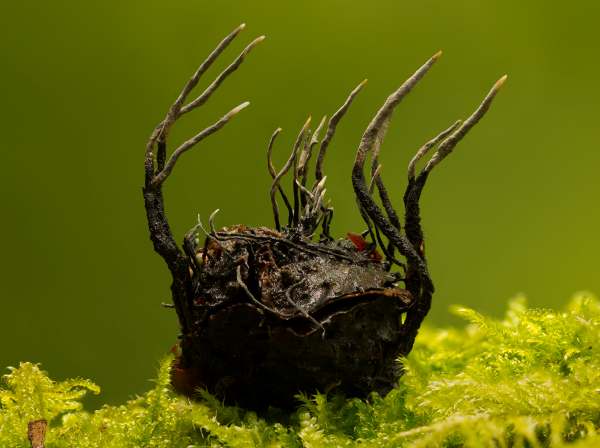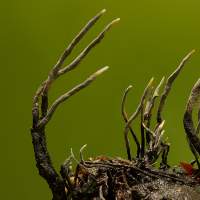Xylaria carpophila (Pers.) Fr. - Beechmast Candlesnuff
Phylum: Ascomycota - Class: Sordariomycetes - Order: Xylariales - Family: Xylariaceae
Distribution - Taxonomic History - Etymology - Identification - Reference Sources

Xylaria carpophila, commonly called the Beechmast Candlesnuff, is instantly recognisable because it grows only from the hard outer cases of Beech seeds, which are known as beechmast. These tough but insubstantial little fungi are not generally considered to be edible.
Distribution
Fairly common in Britain and Ireland, but only where Beech trees grows, Xylaria carpophila is found in many central and northern countries of mainland Europe. This species is also recorded in parts of North America.
Taxonomic history
The scientific name Sphaeria carpophila was given to this ascomycetous fungus in 1796 by Christiaan Hendrik Persoon, but its currently accepted name Xylaria carpophila dates from 1849, when the great Swedish mycologist Elias Magnus Fries transferred Beechmast Candlesnuff to the genus Xylaria.
Synonyms of Xylaria carpophila include Sphaeria carpophila Pers., Hypoxylon carpophilum (Pers.) Link, Xylaria luxurians (Rehm) Lloyd, Xylosphaera carpophila (Pers.) Dumort., and Xylosphaera luxurians (Rehm) Dennis.
Etymology
The genus name Xylaria comes from the Greek noun Xýlon meaning wood - from the same source as the word xylem, which is the wood of a tree that transports water and nutrients from the roots up to the branches, twigs and leaves.
The specific epithet carpophila comes from carpo- meaning a fruit (in this instance the fruit or seed pod of a Beech tree), and -phila meaning loving or fond of. This beechmast-loving fungus is indeed aptly named; it is found nowhere else but on rotting beechmast.
Identification guide
 |
DescriptionThread-like, 2 to 5cm long and 0.5 to 1mm in diameter, sometimes branching.. Initially black near the sterile base and whitish with conidia (asexual spores) towards the tips, the whole of the fruitbody eventually blackens as the ascospores ripen within asci that develop within flask-like perithecia embedded in the surface. (The tiny bumps with minute holes on the outer surface of the upper section of fruitbodies coincide with the locations of perithecia.) |
SporesBean shaped, smooth, 10-13 x 4-5.5µm. Spore printBlack. AsciTypically 120 x 6µm, with eight spores (in a single row) per ascus. |
|
Odour/taste |
Not distinctive. |
Habitat & Ecological role |
Saprobic, in Europe on fallen beechmast (the cases enclosing the seeds of trees of the genus Fagus); however, in North America this species has been recorded on the decaying fruits of hornbeam, dogwood and several other hardwood tree fruits. |
Season |
Throughout the year, but producing ascospores in autumn and early winter, at which times the whole fruitbody turns black. |
Similar species |
Xylaria hypoxylon is similar but much generally larger; it grows on rotting wood. |
Reference Sources
Fascinated by Fungi, 2nd Edition, Pat O'Reilly 2016, reprinted by Coch-y-bonddu Books in 2022.
Molecular and morphological evidence for the delimitation of Xylaria hypoxylon Derek Peršoh1, Martina Melcher and Katrin Graf, Mycologia, March/April 2009 vol. 101 no. 2 pp256-268.
Dennis, R.W.G. (1981). British Ascomycetes; Lubrecht & Cramer; ISBN: 3768205525.
Breitenbach, J. & Kränzlin, F. (1984). Fungi of Switzerland. Volume 1: Ascomycetes. Verlag Mykologia: Luzern, Switzerland.
Medardi, G. (2006). Ascomiceti d'Italia. Centro Studi Micologici: Trento.
Dictionary of the Fungi; Paul M. Kirk, Paul F. Cannon, David W. Minter and J. A. Stalpers; CABI, 2008.
Acknowledgements
This page includes pictures kindly contributed by David Kelly.
Fascinated by Fungi. Back by popular demand, Pat O'Reilly's best-selling 450-page hardback book is available now. The latest second edition was republished with a sparkling new cover design in September 2022 by Coch-y-Bonddu Books. Full details and copies are available from the publisher's online bookshop...

